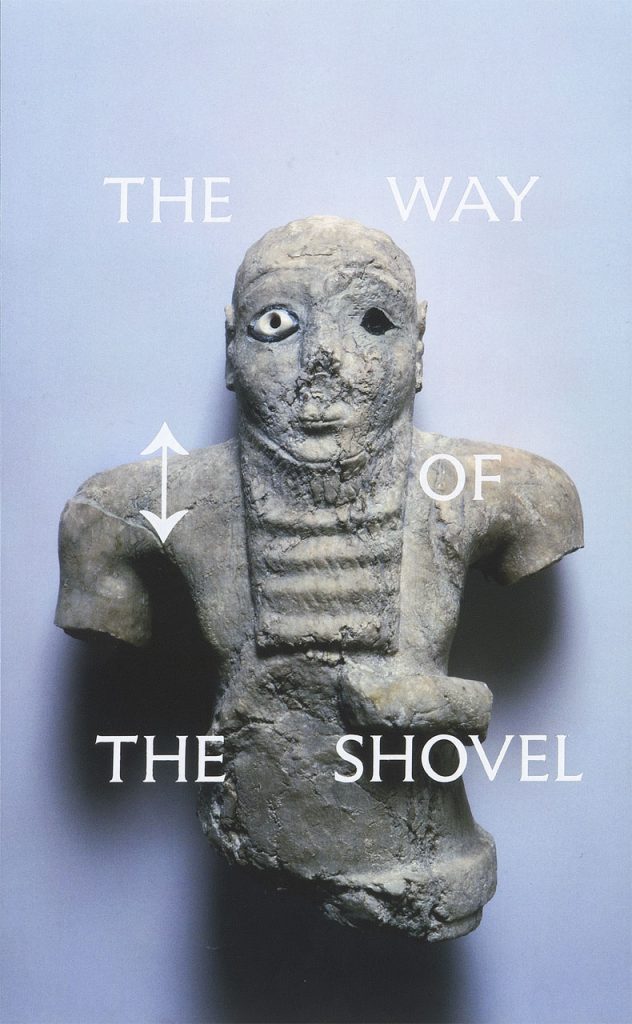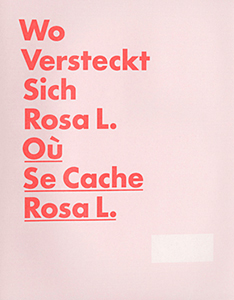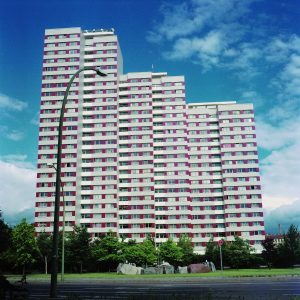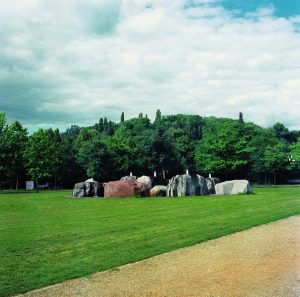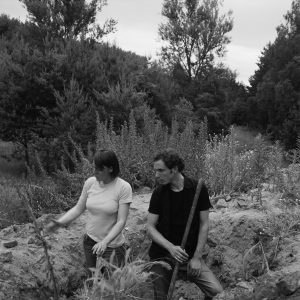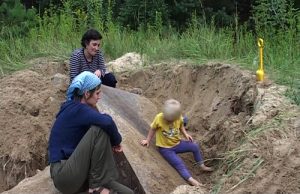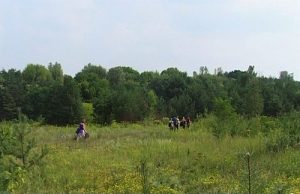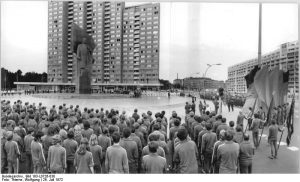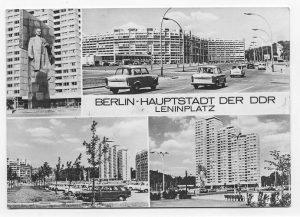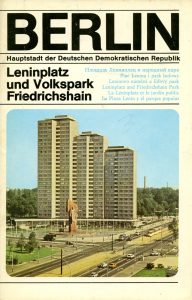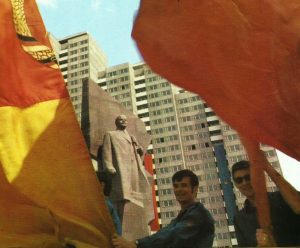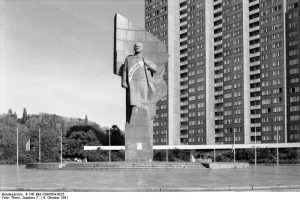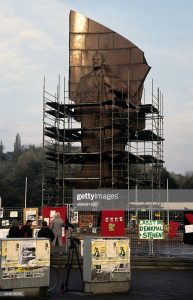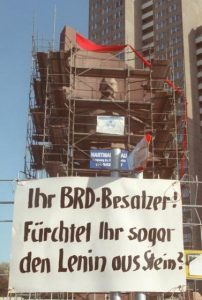A group of friends trip into the forest to unearth a slumbering history. The film explores the publicly manifesting forms of remembering: it looks in an urban environment for traces of the historical events of left-wing resistance and their participants.
Lenin and the sand lizards
Notes on Sand Quarry
In 2001, while researching and taking pictures on different hidden places and histories in Berlin for what has became the book Wo versteckt sich Rosa L./où se cache Rosa L. , I heard about a sand quarry where the biggest Lenin Statue of former east Germany had been buried. Gathering informations from a book written by Emmanuel Terray (Ombres Berlinoises) and from a gardener who was working on the United Nation Square, I went to the forest of köpenick, in the outskirts of Berlin, searching for a quarry, the Seddin sand quarry, not knowing where to locate it exactly.
During my first walk in the forest and around the Müggelsee, I was taking pictures each time I was seeing a monticule of sand, confusing I guess, beaches with sand quarries. While taking the pictures, I quiet liked the idea that the statue could have been burried under a beach used by FKK people, families and playing children. Was it because one could read again in the lanscape a certain collusion between leisure and struggle, leisure and history like one could find in the parisian 1968 grafitti « Sous les pavés la plage »?
Walking around the perimeter of a shooting site protected by hedges, I wondered if the Lenin Statue couldn´t have been hidden under bushes inside the site. I managed to climb the hedges and finally bummed into a place which obviously looked like a quarry onan other edge of the shooting site. Even if the site haven´t been obviously used as a sand quarry for a long time, the deflagration in the geography, the hole in the hill didn´t let any doubt.
It is only after a second walk on the site that I had the chance to see, among high herbs and fine sands and on the side of a tumulus, the almost completely buried red granit block form Ukraine which appears to me as the black block appears to the monkeys in the film Space Odysee. It was sunny and very hot, and I suppose that I went to the Seddin lake right after my discovery.
I gave some calls to the Berliner Senat for Culture and to the local forest guards brigade of Köpenick to get more informations and eventually an authorization to film and dig out pieces of the statue and the installation of an information billboard around the statue close to the site, claiming an artistic intervention to give the place more visibility. No one could or were willing to take responsibility, the embarassment was obvious, to who belongs this statue today and who can and wish to be in charge with it ? The Monument Preservation Department of the senat for Culture proposed me to call the Forstamt of Köpenick and the Forstamt of Köpenick gently invitated me to call the Senat… This happened many times during each phone call.
Between 2002 and 2004, I finally decided to organize on my own small journeys on the site. This 19 meters high statue stood until 1991 in Berlin center, on the former Lenin Square which was renamed later the United nations square. The statue had been inaugurated in 1971 for the hundredth anniversary of his birth, it stood In Situe between the architectures and urban planning of Henselmann and the Friedrichshain´s park of the people.
These journeys aimed to have a pick nick on the site and to try to dig out some parts of the statue. Free will action and leisure : it was more about marking the place of our presence, having a pick nick and diging a bit than finding the statue itself. Of course, it has been each time nice to see again the red granit from Ukraine and to stroke and slide its concrete materiality. But there was always a doubt which part of the statue each blocks we found could have been originally. A part of the flag ? of the socle ? An elbow? Between each trips, the forest guards burried again the blocks we could dig out with sand obviously using a caterpillar. After the second trip, they add some construction wastes over the whole tumulus that we couldn´t pretend to dig out anymore with the shovels we had. I realized in 2005 a short film named Sand quarry out of the video documentation of these trips.
Shortly after our first expedition where we had the chance to dig out few blocks of the Lenin statue, a member of the PDS party, the former communist party of germany, complained in a newspaper that thieves have been trying to steal the statue (I guess without knowing that each blocks weight many tones and that it is just impossible to take away without massive technical support and machines) and that the site needed protection. The statu quo around the statue and maybe as well around the symbolic of its potential political, esthetical and ideological legacy it could carry with, seems obviously for a majority to burry it. But for different reasons, creating a weird double bind : for some people, to burry the statue in the outskirts of Berlin was like a funeral without ceremony to forget and be released of an heavy burden, for others, on the contrary, to let the statue in the underground was symbolically protecting it from iconoclasts.
Later, someone brought a bench until the sandquarry close to the tumulus, obviously knowing as well about the place. It stays there for few years and was removed or felt apart recently.
From 2009 to 2013, sporadic gossips could be read in local berliner newspapers about a spectacular historical show supposed to be held in the Zitadelle of Spandau where the head of the statue was supposed to be dig out and put on display. As a relic, a commodified trophy and the ultimate attraction for mass tourism ? To be followed.
Schatten der Geschichte
Raphael Griseys Beschäftigung mit verschwundenen Denkmälern
Manches wirft einen Schatten, selbst wenn es schon längst nicht mehr existiert. Und diese Schatten können einen dann um so mehr beschäftigen. So ist es auch bei dem 1979 nahe Paris geborenen und nun in Berlin lebenden Künstler Raphael Grisey. Ihn treiben die Schatten der abgerissenen Denkmäler zu einer intensiven Beschäftigung mit der deutschen und Berliner Geschichte.
Berlin ist die Stadt, in der im letzten Jahrhundert deutsche und europäische Geschichte gemacht wurde, die manchmal aber auch nur ein interessanter Spielstein im Machtpoker der Politiker war. Die Spuren sind vielerorts zu sehen und manchmal nur zu erahnen. Seit jeher gilt das Setzen von Zeichen durch Bauten und Denkmäler als ein Mittel der Machtpolitik. In Berlin ist die Geschichte dieser Denkmäler um so interessanter, weil in so kurzer Folge die verschiedensten Machthaber ihre Monumente aufstellen und die ihrer Vorgänger niederreißen ließen. Besonders prägnant ist dies bei Denkmälern des Wilhelminismus, z.B. Siegesallee, Nationaldenkmal, Invalidensäule, und nach 1990 bei Denkmälern der sozialistischen Machthaber in Ostberlin gewesen.
Die neue und alte Machtelite des Westteils der Stadt konnte die sozialistischen Denkmäler im öffentlichen Straßenraum, etwa den Lenin am heutigen Platz der Vereinten Nationen, nicht länger dulden. Man fühlte sich durch den 1970 von Nikolai Wassiljewitsch Tomski in roten ukrainischen Granit gehauenen Revolutionär international blamiert und ließ ihn trotz Protesten und Vorschlägen für einen phantasievolleren Umgang mit diesem Stück Zeitgeschichte abreißen. Als Ersatz folgten fünf Steine von fünf Kontinenten, aus denen nun im Sommer ein bißchen Wasser sprudelt und die vorbeifahrenden Autofahrer an eine provinzielle Kurstadt erinnern. Die Hochhäuser, die als Umrahmung des monumentalen Lenins gedacht waren, haben ihren städtebaulichen Sinn verloren.
Raphael Grisey machte sich vor zwei Jahren auf die Suche nach den Resten des Denkmals, seitdem er vor einigen Jahren über dessen Schicksal in dem Buch Ombres berlinoises (Berliner Schatten) von Emmanuel Terray gelesen hatte. Nach längerer vergeblicher Suche ist er inzwischen fündig geworden und hat zusammen mit Freunden Teile der einst 20 Meter hohen und aus 125 Stükken bestehenden Figur nahe dem Müggelsee ausgegraben.
„Aber ich werde ihn dort lassen, denn unter dem Sand und den jungen Kiefern ist er sicher”, sagt Grisey und weist auf Videodokumentationen dieser „Grabungsperformances” hin, die als Kunstwerk ausreichen müssen. „Mir geht es mehr um eine Bewußtmachung im Umgang mit Geschichte”, erläutert er den Sinn seines Unternehmens.
Letztendlich war die Beschäftigung mit dem „entsorgten” und versteckten Lenin auch Auslöser, sich mit anderen Berliner Denkmälern zu beschäftigen, u.a. mit dem Grab von Ulrike Meinhof, den verschiedenen Rosa-Luxemburg-Gedenkstätten oder auch nationalen Symbolen wie dem Reichstag und dem Brandenburger Tor, von dem er einen Nachbau in Butter anfertigte, der nach einiger Zeit ranzig wurde. Ihn interessiert, wie man eine persönliche Haltung des Gedenkens zu eher unpersönlichen, teils abstrakten Orten und Geschehnissen jenseits der eingespielten Riten gewinnen kann.
Einige Denkmäler baute er stark verändert als Möbel nach, mit der Absicht, das Gedenken und Erinnern in den Alltag zu integrieren. So steht nun sein Fernseher auf einer Badewanne, die als Sockel für den Nachbau der Wandlitzer Siedlung diente.
Nachdem er seine Objekte zur Berliner Denkmalsgeschichte mehrmals zusammen mit seinem Pariser Malerkollegen Fred Bouchet in freien Galerieprojekten und im Kunstraum Kreuzberg im Bethanien ausgestellt hat, will er sich jetzt aktuelleren Themen widmen, z.B. einen Dokumentarfilm über die Arbeitsbedingungen in der Zentrale von Universal Records drehen, denn „mit der Zeit machen die Schatten der deutschen Geschichte einen ganz schwermütig, auch wenn es nur Schatten sind”.
Spunk Seipel 2004
